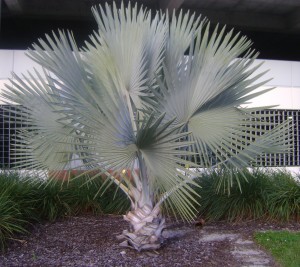Bismark Palm
While a native to Madagascar, Bismarckia nobilis, more commonly known as the Bismarck Palm, is a beautiful tree lending a tropical feel anywhere it is planted. It can grow from 25 to 50 feet high, and has an large canopy, consisting of four foot leaves and beautiful flowers that can spread a width of 15 to 20 feet. After flowering, the tree will sprout small, round, non-edible fruits, approximately an inch in diameter. Because of the width of the canopy as it grows, spacing will need to be taken into account when planting them. Also known as the Bismarckia Palm or the Nobilis Palm, they are a relatively new addition to the Tampa Bay area landscape, and are desired by locals as well as tourists.
The 50 foot height and 20 foot canopy of this tree are most often found in the wild in Madagascar; generally, a cultivated version of the Bismarck Palm will not exceed 35 feet or so, with a canopy reaching somewhere around 15 feet. Even at that size, though, the plant provides plenty of shade when mature. Its thorny trunk measures roughly 30 to 45 centimeters, with it broadening at the base a little bit. As the foliage doesn’t grow anywhere on the plant except its youngest parts, the trunk is leaf-free.
| Names | Bismark Palm, bismarkia nobilis |
| Plant Type | Solitary Palm Tree |
| Hardiness Zones | 10a-11 |
| Blooms | In Late Spring/Early Summer |
| Light Needs | Moderate to High |
| Water Needs | High Drought Tolerance |
| Soil Needs | Moist, Well-Drained |
| Cold Tolerance | Moderately Cold Tolerant |
Care Instructions
By all accounts, once planted in the ground, the Bismarck Palm does not transplant well. With that said, however, successful transplantation can take place from a pot to the ground. The soil in the earth needs to be roughly the same consistency as in the pot, otherwise the tree may have difficulty taking root. A great way to alleviate this issue is to fill the pot with soil from the area in which you are going to ultimately plant the tree. Better yet, plan ahead, space correctly and just plant the seed in the earth to begin with. Generally referred to as a low maintenance plant, one need not worry about planting in the shade; as long as Bismarckia gets some water and sun, it can tolerate a dry spell for some time.
Rated for the 10a to 11 hardiness zones, this tree does well in an area like central Florida. Its trunk is composed of hard wood; not necessarily an oak, but it is resistant. The palm can handle moderate to above average hurricane winds, and, barring a catastrophic storm, typically won’t bend or bow or break. On the other end of the spectrum, they don’t like the cold. A light frost may shock the tree a little, but mature specimens can recover from temperatures as cold as 23 degrees Farenheit – providing the chill doesn’t last for months on end.
There are a variety of ways to purchase a Bismarck Palm; the price will depend on the stage of growth. Seeds can range from as low as four dollars for three seeds.
These are great plants, especially in a tourism-driven area such as central Florida. They’re hardy, shady, relatively easy to grow and give off an uber tropical feel, adding value to tropical and sub-tropical landscapes.






